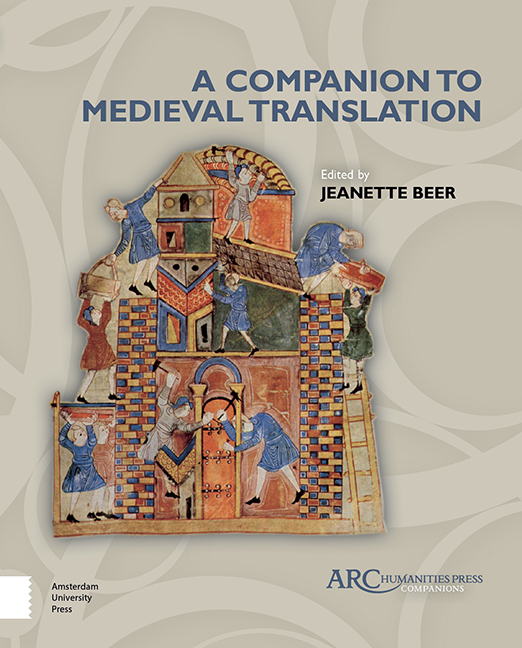Book contents
- Frontmatter
- Contents
- Acknowledgements
- Introduction
- Chapter 1 The European Psalms in Translation
- Chapter 2 The Old French Bible
- Chapter 3 Middle English Religious Translation
- Chapter 4 Bible Translation and Controversy in Late Medieval England
- Chapter 5 Medieval Convent Drama: Translating Scripture and Transforming the Liturgy
- Chapter 6 Translating Romance in Medieval Norway: Marie de France and Strengleikar
- Chapter 7 Christine de Pizan, Translator and Translation Critic
- Chapter 8 Translation, Authority, and the Valorization of the Vernacular
- Chapter 9 Vernacular Translation in Medieval Italy: volgarizzamento
- Chapter 10 Dante and Translation
- Chapter 11 Chaucer and Translation
- Chapter 12 Alchemy and Translation
- Chapter 13 Scientific Translation: A Modern Editor’s Perspectiv
- Chapter 14 Modern Theoretical Approaches to Medieval Translation
- Chapter 15 Observations on Translation by a Thirteenth-Century Maître: Li Fet des Romains
- Epilogue. Observations on Translation by the Oxford Professor of Poetry: Pearl
- General Bibliography
- Appendix
- Index
Chapter 12 - Alchemy and Translation
Published online by Cambridge University Press: 20 November 2020
- Frontmatter
- Contents
- Acknowledgements
- Introduction
- Chapter 1 The European Psalms in Translation
- Chapter 2 The Old French Bible
- Chapter 3 Middle English Religious Translation
- Chapter 4 Bible Translation and Controversy in Late Medieval England
- Chapter 5 Medieval Convent Drama: Translating Scripture and Transforming the Liturgy
- Chapter 6 Translating Romance in Medieval Norway: Marie de France and Strengleikar
- Chapter 7 Christine de Pizan, Translator and Translation Critic
- Chapter 8 Translation, Authority, and the Valorization of the Vernacular
- Chapter 9 Vernacular Translation in Medieval Italy: volgarizzamento
- Chapter 10 Dante and Translation
- Chapter 11 Chaucer and Translation
- Chapter 12 Alchemy and Translation
- Chapter 13 Scientific Translation: A Modern Editor’s Perspectiv
- Chapter 14 Modern Theoretical Approaches to Medieval Translation
- Chapter 15 Observations on Translation by a Thirteenth-Century Maître: Li Fet des Romains
- Epilogue. Observations on Translation by the Oxford Professor of Poetry: Pearl
- General Bibliography
- Appendix
- Index
Summary
The history of alchemy is a history of translations. Born in the crucible of Greco-Roman Egypt, alchemy was primarily an amalgamation of Egyptian metallurgical practices and Greek philosophy with certain Judaic influences. Many of alchemy's origin myths concern the translation of alchemical secrets from foreign and ancient gods to mankind. The secret of alchemy was a powerful truth that could never be fully translated. In the first seven centuries of the Christian era, alchemy was largely retained in the Greek language. With the birth and expansion of the Islamic Empire in the seventh and eighth centuries, alchemical knowledge, together with a truly remarkable number of Greek scientific and philosophical texts, was translated into Arabic. Alongside the works of Aristotle, Galen, and Hippocrates, alchemy received great attention by some of greatest Arabic philosophers. In the twelfth century this Arabic-influenced alchemy entered into the Latin West through programs of translation, such as that of the prolific translation school at Toledo. It was not until the fifteenth century that the secrets of alchemy were translated into the vernacular tongues in large numbers. At each stage of this history, alchemy was not only translated but also transmuted. Each time it was carried across from language to language, even from alchemist to alchemist, it became something different from what it had been before.
Alchemy was concerned with making things look like something else. Greco-Egyptian alchemists manufactured alloys, purified metals and gems, created dyes and gilded base metals. Compared with the philosophical questioning and linguistic obscurity that came to define later iterations of alchemy, the earliest extant witnesses of alchemical writing provide a clear idea of what exactly alchemists were doing. The Leiden and Stockholm papyri, composed in third-century Egypt, contain 255 Greek recipes for how to make certain dyes, how to make imitation precious stones, and how to make metals look like gold and silver. Although the nature of some ingredients was hidden behind jargon that is difficult to comprehend, these recipes are relatively straightforward and largely replicable: “Ασήμον ποιήσϵις Κασσιτέρου ∠ιβ’, υδραργύρου ∠δ’, γῆς Χϵίας ∠β’· χϵνϵύσας τον κασσίτϵρον ἐπέμβαƛϵ τὴν γῆν τϵτριμμένην, ϵἶτα τὴν υδράργυρον, καὶ κϵίνϵι σϵιτήρω καὶ χρῶ.” (Manufacture of Asem. Tin, 12 drachmas; mercury, 4 drachmas; earth of Chios, 2 drachmas. To the melted tin, add the crushed earth, then the mercury, stir with an iron, and put (the product) in use.)
- Type
- Chapter
- Information
- Companion to Medieval Translation , pp. 143 - 152Publisher: Amsterdam University PressPrint publication year: 2019



